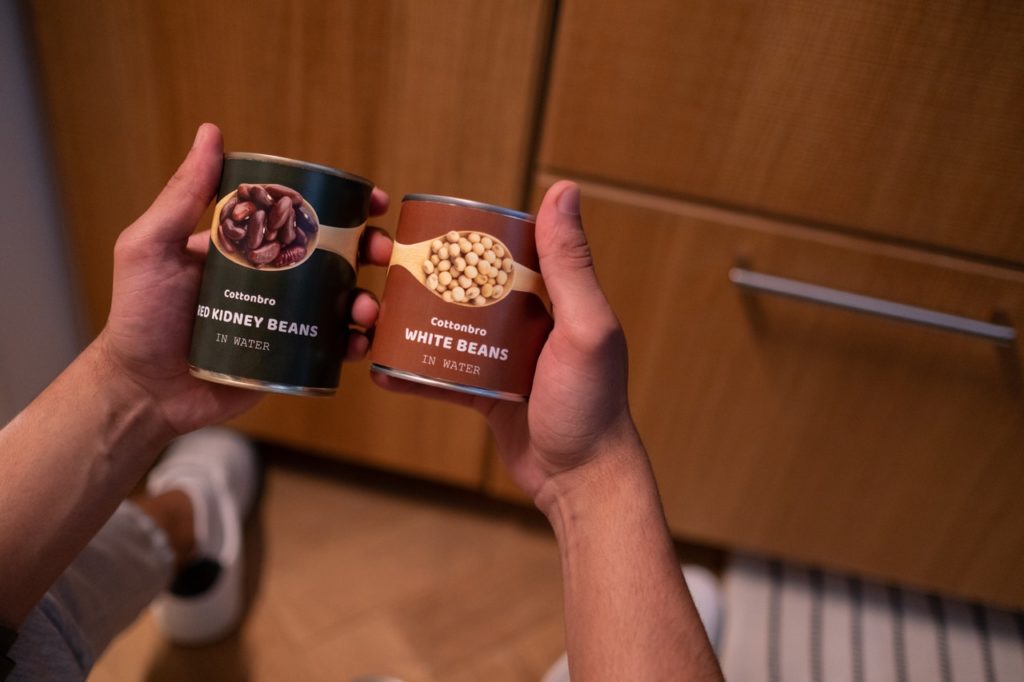I learned this today. Canning preserves food by killing all of the bacteria present through heat and then keeping the food in a bacteria-free, airtight can.
For food to rot, bacteria need water, oxygen, a neutral pH level, and a warm temperature. The different ways of preserving food each deal with one of these. Freezing food lowers the temperature and makes it too cold for bacteria to metabolize the carbohydrates in the food. Salting the food removes the water. Pickling the food lowers the pH and kills the bacteria. Fermenting the food also lowers the pH level and makes it inhospitable for bacteria. Canning goes the temperature route. In canning, the food in the cans is heated enough to kill all of the bacteria.
Food in cans is prepared and then sealed in the can. This used to be done by hand, but they are all made by machine now. The food to be canned is thoroughly cleaned and prepared first. Then it is loaded into the can. The can is still open at one end at this point.
The open can loaded with food is passed through an exhaust box. Here, steam is forced into the can, heating the food and making it expand. The steam pushes as much air out of the can as possible and the can is immediately sealed. After the can is sealed, the steam condenses and cools down, contracting and creating a vacuum.
The lid of the can used to be soldered or welded on, but this would introduce dangerous metals into the food, and it would be a weak point where the can might fail. These days, cans are sealed with a “double seam” method. The double seamer machine overlaps the two layers of the can and the lid to form a sealed hook. This is resistant to leaking and makes a completely airtight seal. Because badly sealed canned food can be invaded by dangerous bacteria, such as botulism, the double seamer machine has to be checked every thirty minutes.
Once the cans are sealed, they are heated. The temperature and the length of time they are heated for depends on the food inside them. Acidic foods, like some fruit and pickles, don’t have to be heated as much because their acid content will already kill any bacteria. Most foods, such as meats and fish, are heated in a pressure cooker. They are heated at 115℃ for about three minutes. This sterilization process is enough to kill all bacteria. Then the food in the can cools, creating an airtight vacuum, and no new bacteria can get back in.
A can of food can be safe for years, so long as the can remains intact.
The first canned food was invented in France for the French army. Most regular people didn’t travel and ate where they lived, so they had no real need for canned food. Napoleon wanted a way for his army to carry their food with them and he offered a reward for somebody who could find a solution. Nicolas Appert came up with a way of cooking food inside glass jars, which would become airtight when the food cooled, keeping the food from spoiling. He won the reward and invented canning.
In the UK, Frenchman Phillip de Giraird invented the first tin can in 1810. Bryan Donkin and John Hall worked out a way of canning food in it and started a very profitable business selling to the British Army and the Royal navy. Many explorers of the time started to carry canned goods. It took a long time to make each can and it was expensive, but, as more people moved into the cities in the early 19th century, the market grew, mechanization took off, and the price came down.
However, like most things, it took a war for the innovation to really take off. Demand for canned food went through the roof during World War 1. Canned food was a way to supply and feed millions of soldiers spread across Europe. The canning industry leaped at the challenge and never looked back.
Interestingly, the can opener wasn’t invented until 1855 and didn’t become popular until the 1920s. People just opened their cans with knives.
So, canning preserves food by removing all of the air from the can and then heating it to about 115℃ to kill any of the bacteria that is in the food. The double seam on the can keeps it airtight so that bacteria can’t get back in. Canned food can last for years. And this is what I learned today.
Sources
https://www.bbc.com/news/magazine-21689069
https://www.smithsonianmag.com/smart-news/arctic-explorers-uncover-60-year-old-food-stash-180956936/
https://en.wikipedia.org/wiki/Canning
https://www.meatsandsausages.com/canning/food/exhausting-vacuum

